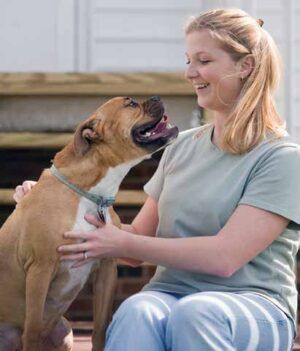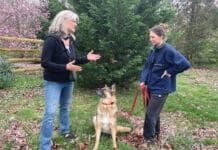
You may have acquired your dog with the intent of competing in agility, doing therapy-dog work, or having fun with musical freestyle (dancing with dogs). Or perhaps you’ve decided to try a new sport with your current dog. These are admirable goals; it’s good to do stuff with your dog! Sometimes, though, your dog isn’t as excited about the activity as you are. What then?
In recent years, dog owners have gotten far better at recognizing the value of giving their dogs choices about their participation in husbandry procedures (see “Care to Cooperate,” WDJ February 2021). Increasingly, we also appreciate the importance of giving our dogs choices about all the other activities we ask them to engage in. We need to remember that just because an activity is fun for us doesn’t necessarily mean it’s fun for them.
Decoding Your Dog’s Communication
I confess I was blind to my own dog’s lack of enthusiasm for agility. I thought we were having a great time! It wasn’t until our Kelpie, Kai, declined to move off the start line in our training class that I realized he wasn’t enjoying the sport at all. I stopped going to class and looked for other activities for us to enjoy together. Now I watch all my dogs more closely to make sure they are having as much fun as I am when we train and play together.
You can find similar examples all over social media. Someone proudly shares a video of their dog doing therapy work at a children’s hospital. The humans are happily smiling as a child hugs the dog – but the expression on the dog’s face says, “Please get me out of here!” Someone else is showing off their recent competitive obedience run, and while the dog is walking in perfect heel position, the stress signals are obvious: panting, tail down, lowered body posture . . .
Starting immediately (if you don’t already!), make it a practice to watch your dogs closely during their encounters with others and activities with you. If you see reluctance to engage or other signs of stress, it’s time to take a step back and rethink your dog’s participation in the activity.
The Consent Test
How do you know if your dog is loving the things you’re asking her to do? Rather than waiting for her to shout her unhappiness as I did with Kai, you can check in with her using an increasingly popular procedure known as “consent testing.” A classic situation where you might use this procedure is when petting your dog or allowing someone else to pet your dog. We humans love to pet dogs, and indeed, some dogs do love being petted – other dogs, not so much. Here’s how a consent test might look for petting:
- Sit down in an enclosed space with your dog off-leash. Be patient.
- Rest one open hand on your leg or lap, palm up. Ideally, the dog will approach you, but you can call her if necessary. No luring with treats.
- When the dog approaches, initiate contact. The best first contact is usually a scratch on the chest. Do not pet the dog on top of her head.
- Use the three-second rule. Scratch/pet for three seconds, then remove your hand. If the dog moves closer or nudges your hand and has a relaxed facial expression, she is inviting more attention.
- Repeat several times, continuing to use the three-second rule. Dogs can change their minds, so even if yours invited additional petting at first, be alert for signs that she has had enough and wants the petting to stop. (This is often when people get bitten – when they fail to notice the “all done” signs!)
Repeat this process when allowing other people to pet your dog.
Here are some other situations where you can apply consent testing:
Interacting with another dog. If two dogs are playing exuberantly and you’re not sure one is having a good time, separate the dogs and move them about six feet apart. Restrain the more active dog and release the one you’re not sure is enjoying the interaction. If that dog stays still or moves away, she’s saying she’s had enough. If she moves forward and re-engages with the other dog she’s saying yes, she wants to play more.
Participating in an activity. Invite your dog to walk toward the hospital (if she’s a therapy dog), training grounds, etc. If she moves eagerly forward, you’re good to go. If she shows any reluctance to move, moves with tension, or exhibits stress signals, you may want to rethink that activity, or start a rehabilitation process.
Rehabilitating Consent
If your dog is telling you she doesn’t want to participate in an activity that you had your heart set on, you have a couple of choices.
You may be able to slowly and carefully work to rehabilitate her association with the activity to help her love it as much as you do. First, have a thorough medical checkup to be sure there’s not a physical reason (pain) for your dog’s reluctance to run fast or jump over jumps or whatever you’re asking her to do. If her vet check is clear, start incorporating small bits of the sport into other activities that your dog really loves.
For example, if your dog loves running in the woods, set an agility jump on the hiking trail and let her hop over it on your hike. Incorporate other play activities with an occasional dance move or dash through a tunnel – play tug, toss a ball, do a quick dance move, and toss the ball again. Do her favorite tricks, run through a tunnel, and do more tricks.
But be careful! If you try to do too much too soon you can poison the beloved activity (give it a negative association) and your dog could end up disliking that activity as well. Go slow, and remember to keep it fun and light. Our dogs often become worried because we seem tense and worried. Keep it fun – and keep doing those consent tests. If you can get your dog to love it, you’re good to go.
Your other choice? Get another dog. Seriously. Keep the first one, of course, but if you have your heart set on doing agility and your current dog is telling you she hates it, your best option may be to adopt another dog who has great agility potential. Do some consent testing first to be sure she isn’t going to tell you “No thanks” from the start, and then go for it. And for your first dog – take some time to find out what she wants to do, and then do that with her.
Signs That Your Dog Likes Petting
- Asks to be petted by moving into your space
- Shoves nose or puts whole body under your hand
- Pulls your hand toward him or her with a paw
- Body is relaxed
- Does a happy-butt dance under your hand
- Eyes get droopy when being petted
- Flops happily onto the floor while being petted
- Flops happily onto you while being petted
Signs That Your Dog Doesn’t Like Petting
- Stands still but doesn’t actively engage with you
- Ducks away when you reach for him or her
- Body is tense
- Moves body away
- Looks away
- Yawns, scratches, licks lips, pants, and/or exhibits other stress signals
- Anything more obvious like growling and snapping






What a great article!
I learned this with my last dog, especially when people wanted to pet her. Whenever someone asks if they can pet my dog, now I say “it’s up to her” and watch her body language.
I often see dogs in public outings/crowded places and you can tell the dog doesn’t want to be there (pacing/zig zagging, panting, tail down) but the owner brings them anyway.
I worked as a therapy dog team with my dog who had practically begged me constantly to let him meet people on the street, so I KNEW he wanted that kind of a job. But there were far too many other teams we worked with where it was evident that they were there because the human wanted it and the dog merely tolerated it at best.
I’ve seen many dogs stress in a performance event due to frustration from poor handling and sub par training. They can move from one sport to another and the common denominator is the owner.
Knowing what motivates a dog can make all the difference combined with a good trainer and training program.
We learned this from our dog when she was recovering from a broken hock surgery. She has always hated rain or getting her feet wet. But thinking she would really like and take to swiming, I enrolled her into aqua therapy to build back the musle in her hind leg. She went because we wanted her to like swiming. Each time around the pool, assisted by the therapist, she would get out and shake herself off. At the end of the scheduled aqua rehad, we decided she really did not like the practice as much as we tried to get her excited about it. The Therapist informed us that she would never be a dog who liked swiming. Hence we ended the sessions.
We thought she liked it since she would be very vocal when we arrived before each session. I think she was more interested and excited in smelling the grass prior to entering the facility. She still hates going into the rain or wet grass to do her business.
I did the same thing, putting my dog in agility. We were on our third week when I put her in the truck and she was so excited ( thinking we were going to her fav off leash area). The excitement disappeared when she realized where we were. I talked with the instructor and let her know we wouldn’t be participating anymore as it wasn’t something that my dog enjoyed. Everyone was happy with the decision, especially my dog when we packed it in and headed out to her fav off leash area.
We definitely have to check in with our dogs to make sure it is something they enjoy as well. 😊
Diana pawPrints loves the dog park. It’s the people park to her as she must go greet all the people before she starts to play with dogs.
Freyja, a rescue, was not a fan the first time. The second time she opened up a little. but was still just clingy and observant. But an interesting observant, not a fearful one. I chalked it up to hesitancy from her shelter experience and lack of socialization. Sure enough, by the fourth visit she was running of with Diana to explore and play.
My previous dog, Ramses, hated the dog park. I tried for about a month and there was no change. He was hypervigilant and always by my side, protecting me from any dogs that might approach to kill me and eat my liver. I stopped bringing him.
Diana does nosework (or at least she did before the pandemic) and I was looking for an activity for Freyja. She is majority husky but dog sledding by herself in southern California isn’t very practical. I thought maybe lure coursing would be her thing since she would get to run and chase “prey”. She did OK on the morning practice runs but when it came time for her to do the real thing, she just couldn’t focus. She would run and chase the lure and then go off and sniff some poop or run back to me. So, not her thing. Aside from kissing my face and getting pets I’m not sure what her thing is. I might see if she likes nosework when I start getting Diana back in shape again. I actually looked into bike joring but it’s a bit expensive to get into if it turns out your dog isn’t interested.
They both love pets and attention so no problem there. In fact, as much as they say dogs don’t like to be hugged, both of these do. At night Diana will sometimes crawl right up against me so I have to put my arm around her, then lays her head on my shoulder and sleeps that way all night. At least one of us gets a full night’s restful sleep.